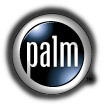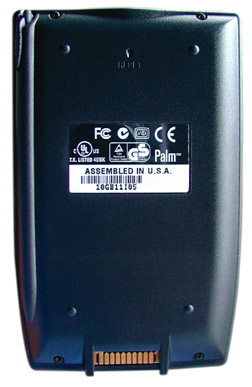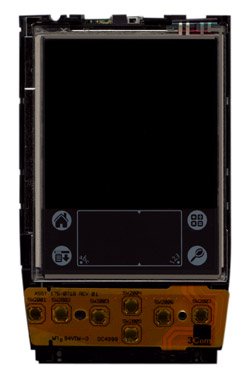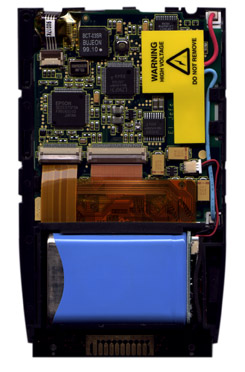 Current Cover
|
|

|
||
Palm IIIcThe favorite handheld computer gets a colorful makeover 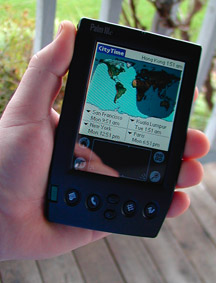
Apparently over a year in development, the Palm IIIc, Palm's first color device, made its debut on February 22, 2000. Its slate-colored case looks similar to Palm III devices that have come before, complete with the flip lid, but there are many striking differences, and many comforting similarities. Many may be disappointed that there are few new software enhancements, but the few are well done, and the new screen with its paper-white background is very nice in most situations. The unit has 8MB of RAM, is rechargeable through the cradle, and Palm claims that it is the lightest color device on the market at 6.8 ounces, only .8 ounces heavier than the Palm IIIx.
Appearance
The unit is longer overall, adding one quarter inch vertically, taking the length to five inches. Following a trend that started with the Palm V, the four main buttons are concave instead of convex, and the rocker-style scroll button has been replaced with two separate buttons, but they are still linked by a small channel meant to emulate the look of the existing Palm III models. The blue/green power button of units past has been replaced with a longer button that is forest green.
More unusual is how the screen looks with the unit off. The Graffiti screen area is slate black to match the screen, with gray lines and icons. The overall appearance is reminiscent of something from Darth Vader's office, or else from the latest Star Trek Enterprise E. The effect is slick.
Also of interest is that this particular Palm has a single silver logo in the upper left hand corner: Palm IIIc. There is no 3Com, no US Robotics. They even have a new logo on the box, and the cradle now says only "Palm," all signs that Palm will soon be free.
From the top of the unit, you can see a larger IrDA window, placed a little higher up. Also on top, visible from the front as well, is the charge indicator light. This verifies that the unit is in the cradle and charging, and unlike the light on the Palm V's cradle that never goes out, the Palm IIIc's light goes out when the unit is fully charged. From the back, you can see that there is no battery door, and likewise the serial port contacts are no longer covered by the spring-loaded door that we've seen on other Palm IIIs and the Palm VII. Apparently this door was never really necessary, but was included to allay the fears of those who thought they would get shocked by touching the contacts, or else short the unit out. I have it on authority that there is no danger of this.
The Reset button has moved to the top center, and they've done a funny thing with the Pen. The early Pilot pens were removed by grabbing a protrusion that came out the side of the unit. When the Palm III came out, the pen was accessed 90 degrees from the original, at the back of the unit. The Handspring Visor returned to accessing the Pen from the side, and now the Palm IIIc throws in a new twist: the pen is accessed 45 degrees from the original. All these differences won't matter much to the user who owns a single device, but it's a bit of a nuisance to the Palm Editor who uses all of them.
Yeah, yeah, what about the screen?
Well, the screen is remarkable. After spending the last couple years peering deep into the monochrome LCDs, tilting it this way and that to gather the light necessary to access my data, it's shocking to have the light come bursting from the screen with no extra effort necessary. Until I saw this screen, I really hadn't noticed how it often feels like you're having to pull light out of the regular screen, especially when indoors. The newer screens on the units that came out with the debut of the Palm IIIx and Palm V have made it a lot easier, but nothing like this.
The Palm IIIc has a very bright active matrix TFT (thin film transistor) display. Many have been predicting that Palm would use an HR-TFT, which has excellent readability outside and good readability inside, but that was not the case. While the HR-TFT is reflective, meaning it works with reflected light instead of transmitted light, it has never been really great indoors. It cannot be backlighted, because it is not transflective like the monochrome Palm screens, so it must be sidelighted: a method that results in lighting up the cover glass more than the screen. The Compaq Aero 2150 and Nintendo's Game Boy Color have this screen technology, but sidelighting the screen doesn't produce the vibrant colors and contrast that a transmissive TFT does (the Game Boy has no sidelight).
But there's always a trade-off. In this case, the old, monochrome screen becomes the screen of choice for outside use, where there's plenty of light, and the new color screen is better kept inside, where there's less light to compete with. Outside, the new color screen blacks out. Much as it would be if you brought your monitor or TV outside, the coating that makes your black pixels so contrasty inside becomes dominant outside, since the daylight is brighter than the light coming through the LCD. Your eyes close down to compensate for the greater light levels overall, and what once appeared bright is now very dim, if not completely black. You see this effect with notebook computer and digital camera screens as well. Truthfully, however, the Palm IIIc is still usable even in bright direct sunlight, at least as tested in our Northern California Winter sunlight, which is admittedly subdued compared to Summer light. You do have to struggle to eliminate reflection as though you were looking at a Palm III indoors, but it's not impossible.
We compared the screen, very informally, to the Compaq Aero 2150 and the Casio E-105 in direct sunlight, and the Palm IIIc had the greatest contrast, brightness, and readability. We attributed this mostly to the significantly larger pixels of the Palm IIIc. Many might not like that the new Palm has only 160x160 pixels, but the higher contrast afforded by this pixel size has paid off, both now and in the past, with greater readability than the competition. And getting your data is what Palm Computing is about. Palm spent more than a year selecting this screen, and it looks like they've made the best choice from the currently available technology.
Inside Last year when the new Palm OS 3.5 was shown to developers at PalmSource 99, Motorola made their announcement of the new DragonBall VZ processor that would support 256 colors and run at 33MHz. I expected that this was what the Palm IIIc would be running, but it turns out that it's running the same processor as the Palm Vx: a 20MHz DragonBall EZ; apparently this processor can handle 256 colors as well.
Using Neil Bridges' Benchmark program, the unit scores 138 percent the speed of a Palm IIIx or Palm V. The Palm Vx with the same processor as the IIIc, scored 121 percent. There's no telling whether Bridges' program should be updated for the new OS, or if Palm has souped things up a bit.
The battery, unlike the slim Lithium Ion battery of the Palm V, is just a little smaller than three AAA batteries would be, and maybe a little thicker. It is a Lithium Ion cell, and Palm says it will last up to two weeks, depending on the brightness setting of the backlight. Judging from the size of this battery compared to the smaller-than-a-stick-of-gum size of the Palm V's battery, it takes a great deal of energy to run the TFT. After a day of general fiddling with the unit for this review, the battery meter still reported full with no recharge performed all day. Using the "Stay on in cradle" option causes the unit to warm up a little after a day in the cradle, but it doesn't get hot by any means.
Software
The Palm IIIc uses Palm OS 3.5, the first OS to support color. There are also some refinements to the basic applications. In the AddressBook for example, users can make a copy of an existing address. This will be especially useful when you want to add an address for a different person who works at a company you already have the basic information for. Just select Duplicate Address from the menu and a copy is created with the word "Copy," highlighted in yellow, following the name in the First Name field.
The Date Book adds an Agenda view, which includes both your appointments for the day and items from your To Do list, and the alarm now includes a snooze button so you can use it as a wakeup alarm on trips--finally, functionality that will be appreciated on exhausting trips.
In programs that support it, which appears to mean any program with a tab at the top, you can now tap on that tab and access the menu. This is certainly more intuitive than tapping on the lower-left corner of the Graffiti area.
Performing a command stroke (a single line from lower left to upper right in the Graffiti area) now brings up a context-sensitive icon bar at the bottom of the screen for those programs that are written to use it. In the Applications view, for example, you're presented with an Info icon, which brings up the Info window; a beam icon, and a trashcan icon bring up their own respective windows, obviating the need to use the menu for these items. I suppose they didn't make shortcuts for the other menu items because "Category" and "Preferences" are hard to represent with an icon. It will be interesting to see how programmers use this feature in the future, though it currently does little to minimize taps: rather than tap the menu and select the item, you make the stroke and select the item; both steps require only two actions, so the benefit is unclear.
Use of color
Color is used conservatively on the Palm IIIc. The background of all programs is bright white, and the tabs, bounding boxes, and selected items are blue. Highlighted text is yellow, the backgrounds of many icons are baby blue, and some icons have a few colors. Non-color-enabled programs appear in black on white as usual. There is already a third party program available to change these colors, but I haven't played with it yet.
One of the first color programs I have seen is Code City's CityTime software. The world map is far superior to the old black and white map--which is saying a lot--offering a feel of depth and richness never before seen in a Palm program. Color does add something special.
The shipping version of the Palm IIIc is supposed to include four color-enabled software programs that were not included for my advance review. First there's Album To Go from Club Photo, which offers easy download of color JPEG images to the Palm IIIc. PowerOne is an enhanced color calculator from Infinity Softworks, offering business and scientific functions. Chroma Gammon is a color backgammon game, and AvantGo's new color browser is also supplied, offering both offline channel viewing and live website browsing, in color where supported. I tried downloading the new AvantGo color browser, but while one of the icons had some color, and the tab had color, I was unable to find any channels or browse any web pages in color. Perhaps in the future such support will be available.
Compatibility
The Palm IIIc is a bit longer than the other Palm III devices, due mostly to the larger battery, but it is still compatible with the many peripherals designed to snap onto the bottom. Because it is taller, it cannot work with products like the Novatel Minstrel III, since this snaps on by clamping onto both the top and bottom of the unit. (Novatel has announced a new modem for the Palm IIIc.) I was able to use the standard Palm Modem that was originally designed for the Pilot with no problem.
The cradle that comes with the Palm IIIc looks like any other Palm III cradle, but this one has charging contacts. For HotSyncing, all Palm III-type devices will work with either cradle, but charging for the Palm IIIc must take place on the IIIc cradle.
As for software compatibility, there are some problems with certain programs that write to the screen in unusual ways. The original version of Album To Go, for example, runs but does not actually display the photos. AstroidsGS does not work at all; here's hoping they come out with a color version of that soon.
The IIIc is also compatible with the newly announced Kodak Snap-on digital camera. The US$149 unit will enable Palm IIIc owners to take 24-bit color photos in 640x480 resolution, though they will only be displayed on the Palm in 160x160 resolution. The unit will work with any Palm III or Palm VII-series device.
Also designed for the Palm IIIc is the Auto/Air Recharger Kit that will recharge the unit in either an automobile lighter socket, or the charger socket available in most business or first class airline seats; and then there's the standard Recharger Kit that will work with a US wall outlet, and includes adaptors for the UK, Europe, and Australia. Each kit is US$39.95.
Overall Impressions
The Palm IIIc has been a long time coming. Many color Windows CE machines arrived and died out while Palm carefully considered whether to even produce a color device. Despite their monochrome status, the Palm community continued to snap up Palm devices over their color competitors, and new users were attracted by the sleek looks of the Palm V and the communication ability of the wireless Palm VII. Overall, everyone was attracted by the devices' simplicity, utility, and long battery life. The prevailing wisdom is that for data purposes, one needs no more than black and white; or in the case of Palm, black and silvery green. And that's correct. The basic Palm serves up phone numbers and other data just fine with good old black and white. Just like the original Apple II or IBM PC served up data on green and black.
Color opens more doors, however. Just like that transition from text to Graphical User Interface, or the change from Black and White to Color on the desktop, this transition to color may be the natural evolution as these small computers begin to accompany more of us in our daily lives. Many people have eschewed Palm devices in favor of color Windows CE machines just because they really wanted to carry color photos of their kids with them on their organizer. While the Windows CE devices still have higher resolution, the ability to display 64K colors, and even play movies, the Palm IIIc will attract many of those folks wanting to carry a few simple snapshots as well as have the easy-to-use and most popular handheld computer in history.
In use the Palm IIIc is a pleasure. The case feels strong, considerably stiffer and sturdier than past Palm III units. Its dark slate case is handsome and the buttons are responsive. The screen is very bright and the colors are vibrant. Holding down the power button, instead of turning on the backlight as it does on other Palms, brings up the brightness control. Indoors in the evening, you may want to turn this down for reading a novel or playing a game; this will both save batteries and save your eyes, as the screen can be a bit too bright in low light situations. Like many TFTs, the screen is better viewed straight on. It gets darker from the left, and brighter from the right, yet stays more even when tilted top to bottom. The dark lines between pixels can occasionally be distracting, causing your eyes to catch the pattern, but holding the unit further away seems to alleviate the problem. The software responds as quickly as any other Palm and works just as well.
At US$449, the Palm IIIc comes up beside the Palm VII in price, offering yet one more choice among Palm OS products currently on the market. Though I think many of us will stick to monochrome devices for a while, I suspect this is one choice many people have been waiting for.
-Shawn Barnett
For more information, visit their site: www.palm.com
To see commentary on the Palm IIIc from Pen Computing's Editor in Chief, click here.
| ||||
|
[Homepage] All contents ©1995-2000 Pen Computing Magazine, Inc. All rights reserved. |
||||

